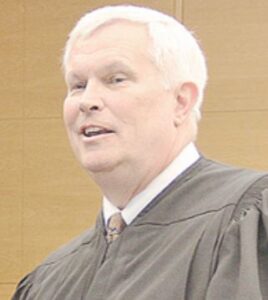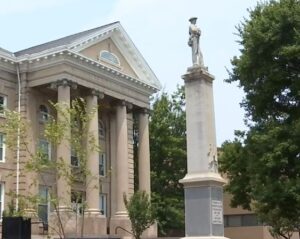The Roanoke County Courthouse is located, oddly enough, in the independent city of Salem. Nearby, within the sight of the courthouse, there stands a statue of a Confederate soldier in front of a building owned by Roanoke College. The college would like to remove it, but the statue is situated on a scrap of land owned by Roanoke County, and only the Board of Supervisors is empowered to make the decision. The County has not been moving on the matter as expeditiously as some would like, and now Roanoke County Circuit Court judge Charles Dorsey has determined that the statue “obstructs the proper administration of justice in the Roanoke County Courthouse.”
The arguments in favor of keeping the Confederate statues are familiar to us all, and I will not re-hash them here other than to note that this particular statue, raised in 1909, does not glorify the Confederacy, the ante-bellum era, or the mythology of the Lost Cause. The placard says simply that it was erected “in memory of the Confederate soldiers of Roanoke County. … Love makes memory eternal.”
My interest here is not to re-litigate the propriety of maintaining a statue that honors nameless Confederate soldiers but to highlight Dorsey’s judicial activism. Impatient with the processes of representative democracy — the county board will not take any formal action until January 2022 — he has issued an order:
Either the Court must be removed to an appropriate location or the monument must be removed during the operation of the Court, the Court so finds, and the same is ORDERED.
Really? Can a judge do that? What happened to the separation of powers? Are we still a democratic republic?

It is not clear what precipitated this decree, but in a letter to County Chairman P. Jason Peters, Dorsey indicates that Roanoke College is committed to removing the statue and has offered to cover the cost of doing so. The controversy has been brewing for some time. He also described an incident that occurred about two weeks before he wrote the letter.
I looked out my window in the courthouse and saw a young woman, who appeared to be African American, walk by the statue of the armed Confederate on Main Street. She turned right onto College Avenue, and without breaking her stride, looked up a the statue, looked down immediately, and began shaking her head. While I could not accurately describe her reaction as anger, disgust, bewilderment, confusion, or any other emotion, given the brief nature of the observation, almost any emotion encompassed within her reaction had to be a response to the simple question of “Why?”
Why? One answer might be that the citizens of Roanoke County erected a statue to honor the sacrifices — including in many instances death, wounding and amputation — of the men from their community who had fought in one of the great conflagrations of the 19th century.
But Dorsey never considers that possibility. Rather, he ties the statue to slavery, segregation and the Ku Klux Klan. Slavery was the single most important cause of the Civil War. The argument over Confederate memorials, he contends, is tied to the mythology of the Lost Cause, which was inextricably bound with Jim Crow, the Virginia Constitutional Convention of 1902 that stripped black citizens of their Reconstruction era rights, the terror of the Ku Klux Klan, night riders, lynchings, cross burnings, murder, and death. Blacks learned that the cherished “rule of law” often did not apply to them. And even when physical violence receded, he wrote, “economic violence was being wrought by discriminatory banking practices,” segregation and separate-but-equal schools.
The deplorable history of slavery and the Jim Crow era cannot be denied, and one can agree with Dorsey that African American men and women “have a bona fide, objective, fact-based, historically grounded reason to find Confederate glorification offensive.” But he moves from the incontrovertible to very shaky ground, extrapolating from broad generalities to the specific case of Roanoke County:
“The purpose of [the Lee Monument in Richmond] was to recast Virginia’s history; to recast it to fit a narrative that minimized the devastating evil perpetrated on African Americans during the darkest part of our past.” It does not matter the number of African Americans in Roanoke County; it does not matter whether any citizen is offended; it only matters that this monument’s message, in its present location, is offensive to the appearance of judicial fairness and neutrality, without a hint of prejudice.
In effect, Dorsey is implying that all Confederate statues were erected during the early 1900s to give physical form to the Lost Cause narrative and continued oppression of Blacks. Yet he never addresses the reasons given for erecting the Roanoke County statue. He offers not one scintilla of evidence that the purpose of this particular statue was to cement the system of white supremacy. Most astonishingly, he doesn’t even cite the monument’s plaque, which recognizes the wartime sacrifices of a passing generation of veterans. The monument is explicitly an expression of love: “Love makes memory eternal.”
In the world at large, people are entitled to feel what they please with no empirical justification. But Dorsey isn’t Joe Sixpack. He’s a judge. And his judicial order was not a Facebook post. It was… a judicial order. One would think that a presentation of all the facts matter.
But the story doesn’t end there. Dorsey makes another huge leap in logic. “Symbols convey the power of meaning,” he continued in his letter. For instance, he argued, no one would suggest hanging a Confederate flag or monument in a courtroom.
Fair enough, symbols do matter. A courthouse must maintain an air of absolute impartiality, and it is up to judges to reinforce the message of impartiality.
But the statue is not located in the courthouse or on the courthouse grounds. It is located some 40 yards away. It is the sight of the monument from his courthouse window that offends Dorsey. Says he: “The Confederate statue casts a literal and metaphorical pall on the administration of justice here in Roanoke County.” In effect, he is extending his writ from the courthouse itself to everything within his field of vision from the courthouse. And he cites no legal justification for doing so.
Whether you believe the statue should go or stay — and I expect it will go — it does not cast a pall on the administration of justice. Such a notion is a figment of Dorsey’s imagination. What concerns me more than the statue’s ultimate fate as determined by the Roanoke County Board of Supervisors is Dorsey’s judicial overreach. When issuing an order, judges are supposed to lay out the facts and arguments of both side of an issue — the plaintiff’s and the defendant’s — and make a ruling in accordance with his interpretation of the law. In this instance, Dorsey has done neither. He cites only one side of the issue, and he cites no law.
Dorsey’s order, based on his personal outrage, amounts to rule by judicial fiat. You can agree with his sentiments, but you should be frightened by the way he gives them the force of law.


Leave a Reply
You must be logged in to post a comment.